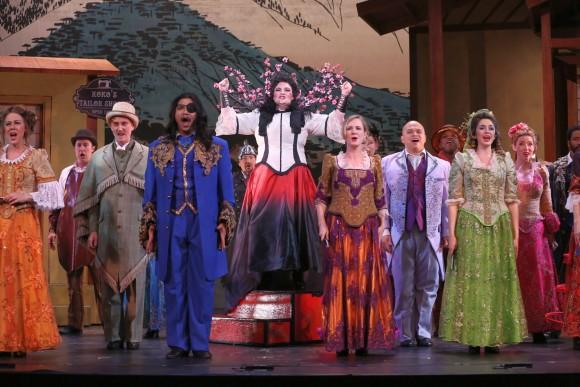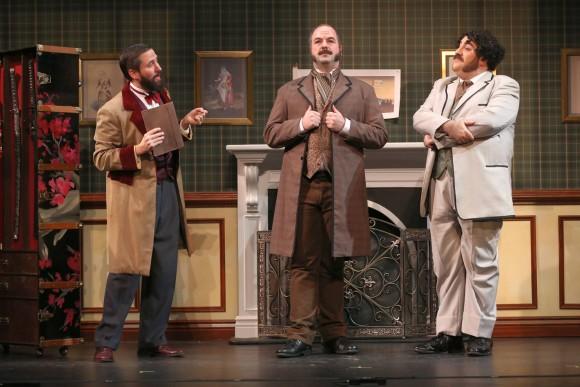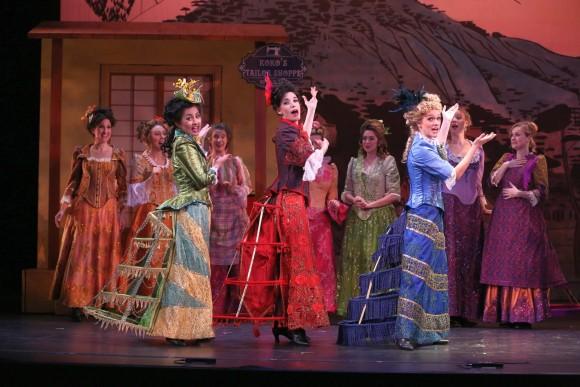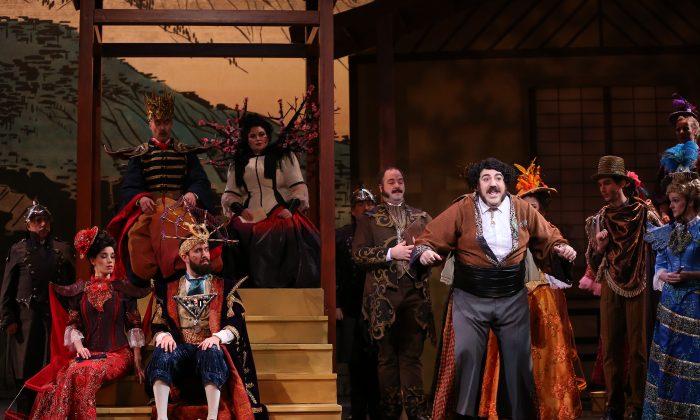NEW YORK—Last year, the New York Gilbert & Sullivan Players abandoned plans to present “The Mikado.” The popular operetta, set in Japan, was traditionally performed by Caucasian performers in yellowface. Just as the Metropolitan Opera decided to do away with Otello’s black makeup in the Verdi opera, so the G&S Players decided to rethink the 1885 piece.
The mostly happy end-result on this occasion is the new “Mikado,” directed and choreographed by David Auxier and presented at Kaye Playhouse at Hunter College (68th Street between Park and Lexington avenues).
The production begins with the sparkling overture, played by the 25-piece orchestra, conducted by Aaron Gandy.

This is followed by a comic prologue, penned by Auxier about the genesis of “The Mikado.” In an office of the Savoy Theatre, the producer D'Oyly Carte urges Gilbert and Sullivan to create a new work. He delivers to them various pieces from an exhibit of Japanese works, which were in vogue at the time. (The opening chorus by the “gentlemen of Japan” refers to their appearance “on many a vase and jar, and on many a screen and fan.”)
Meanwhile, they are repeatedly interrupted by complaining performers from their current production, “Princess Ida.” Auxier fancifully ties these encounters to the names of characters in “The Mikado” (for example, a soprano’s “yum-yummy voice”). Inspiration is also attributed to a blow in the head suffered by Gilbert, the librettist of the pair.
The actors from the prologue double as cast members in the operetta.
The rest of the work is presented pretty much as written, with some references to Japan still remaining but fewer than in the original. Also, the colorful and eclectic costumes by Quinto Ott do not look Asian and the set by Anshuman Bhatia could pass for an Alpine village.
The plot involves the wandering minstrel Nanki-Poo, who is the son of the Mikado of Japan. He ran away in disguise from the imperial court to avoid marriage to an older woman named Katisha. He is in love with Yum-Yum, but she is supposed to marry her guardian, Ko-Ko.
Ko-Ko had been sentenced for the capital offense of flirting but instead was made Lord High Executioner. However, he must find someone to put to death or forfeit his own life. Meanwhile, when Nanki-Poo reunites with Yum-Yum, he learns that his sweetheart is engaged to Ko-Ko.

Nanki-Poo contemplates suicide but Ko-Ko talks him into an arrangement where the minstrel will marry Yum-Yum and one month later be executed—thus Ko-Ko has found someone to put to death and, then, in a month will be able to marry his ward.
Before the first wedding can take place, it is discovered that when a man is executed, his widow must die as well. Ko-Ko has qualms about the plan and decides to sign a false affidavit attesting to the minstrel’s execution.
The Mikado arrives and is pleased to learn that a criminal has been put to death. When he finds out that the beheaded man was his son, the Mikado declares that the guilty parties must pay with their lives.
Ko-Ko seeks out Nanki-Poo to bring him before the Mikado. However, the young lovers have already wed. In desperation, Ko-ko woos Katisha and he is stuck with her while the young lovers triumph.
The cast is terrific, as able with the comedy as the Sullivan’s melodic music: lyric tenor Jesse Pimpinella is Nanki-Poo, the radiant-voiced soprano Quynh-My Luu is Yum-Yum, Andy Herr doubles as Richard D'Oyly Carte and Poo-Bah, Chris Vaughn is W.S. Gilbert and Pish-Tush, Adam B. Shapiro is Arthur Sullivan and Ko-Ko and Cáitlín Burke is Katisha.

Auxier’s direction and choreography are witty and inspired. The removal of the objectionable Orientalisms does not detract from the comedy. There are also some funny references to current events.
On the other hand, the framing device of Auxier’s prologue seems unnecessary. Anyone interested in the genesis of “The Mikado” would be better off watching Mike Leigh’s superb 1999 film, “Topsy-Turvy.”
The New York Gilbert & Sullivan Players will return to Kaye Playhouse with “Patience” (a satire on the aesthetic movement of the late 19th century) on April 29 and 30. The matinee on April 30 will be preceded by a child friendly musical introduction and plot summary one hour and 15 minutes before curtain time.
‘The Mikado’
Kaye Playhouse at Hunter College
695 Park Ave.
Tickets: 212-772-4448 or NYgasp.org
Closes: Jan. 8
Barry Bassis has been a music, theater, and travel writer for over a decade for various publications.







Friends Read Free